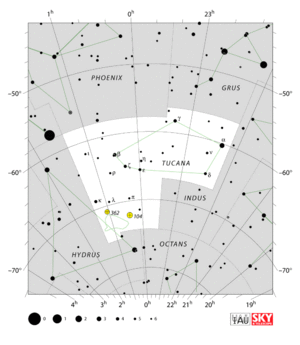Tucana: Difference between revisions
m (→References) |
(added image gallery) |
||
| Line 1: | Line 1: | ||
[[File:Toucan (Bayer 1603).jpg|alt=constellation Tuc in Bayer (1603)|thumb|earliest known depiction of the constellation Tucana in Bayer's Uranometria (1603)]] |
[[File:Toucan (Bayer 1603).jpg|alt=constellation Tuc in Bayer (1603)|thumb|earliest known depiction of the constellation Tucana in Bayer's Uranometria (1603)]] |
||
[[File:TUC (IAU constellation).gif|alt=modern map of constellation Tucana|thumb|Constellation Tucana (modern definition: S&T Graphics)]] |
|||
"den Indiaenschen Exster, op Indies Lang ghenaemt" (the Indian Magpie, known as "Lang" in the Indies) was the original Dutch name of the constellation of the bird that is now called "Toucan" (Tucana, Tuc). |
"den Indiaenschen Exster, op Indies Lang ghenaemt" (the Indian Magpie, known as "Lang" in the Indies) was the original Dutch name of the constellation of the bird that is now called "Toucan" (Tucana, Tuc). |
||
| Line 14: | Line 15: | ||
[http://www.ianridpath.com/startales/tucana.html Ridpath] suggests that the inventor of this constellation was actually Pieter Keyser who had not survived the expedition to the East Indies but had previously visited South America. Hoffmann (2021, 108) suggests Plancius and de Houtman as also possible because baroque ‘wunderkamers’ could certainly have played a mediating role here. Rob van Gent here adds that is not necessary that Keyser, de Houtman or Plancius actually saw a live (or dead) toucan as they are bound to descriptions and depictions of the bird in 16th-century travel literature: in particular Plancius would surely have been familiar with these. |
[http://www.ianridpath.com/startales/tucana.html Ridpath] suggests that the inventor of this constellation was actually Pieter Keyser who had not survived the expedition to the East Indies but had previously visited South America. Hoffmann (2021, 108) suggests Plancius and de Houtman as also possible because baroque ‘wunderkamers’ could certainly have played a mediating role here. Rob van Gent here adds that is not necessary that Keyser, de Houtman or Plancius actually saw a live (or dead) toucan as they are bound to descriptions and depictions of the bird in 16th-century travel literature: in particular Plancius would surely have been familiar with these. |
||
=== Versions === |
|||
<gallery> |
|||
File:Toucan Lacaille Goldbach.jpg|Lacaille's Toucan (1756) |
|||
File:Toucan Goldbach1799.jpg|Goldbach's Toucan (1799) looks like a sparrow |
|||
File:Toucan Bode1772.jpg|Bode's Toucan (1772) |
|||
File:Tuc Bayer.png|Bayer's Toucan (1603) |
|||
</gallery> |
|||
== References == |
== References == |
||
Revision as of 19:24, 5 June 2024
"den Indiaenschen Exster, op Indies Lang ghenaemt" (the Indian Magpie, known as "Lang" in the Indies) was the original Dutch name of the constellation of the bird that is now called "Toucan" (Tucana, Tuc).
Invention & Transformation
The southern star catalog by de Houtman and Keyser was published by de Houtman in 1603 as an appendix to a dictionary of the Malaysian (and other) language(s). This star catalog was written in Dutch and never translated.
Before the publication of the star catalog, de Houtman has shared his data with Petrus Plancius who had actually commissioned this work. Even in the 1590s Plancius had worked with this material and his celestial globe of 1598 already displayed paintings of the newly invented constellations in the south. The images had the labels "Indian" and "Toucan" left and right of the bird, while the left label ("Indian") also referred to the male figure northwest of it. Petrus Plancius' work and/or its copies by W. J. Blaeu served as source for Bayer's Uranometria (1603). Bayer's map of the south pole also displays the image with the label "Toucan" and an extraordinarily long beak.
Species of this bird
The additional phrase in de Houtman's catalog, mentioning that the bird was named "Lang" is occasionally misinterpreted to be the cause for this depiction, implying that "Lang" in Dutch means "long" and refers to the beak. In de Houtman's days the Dutch word for long was usually spelled as "lanck", so "Lang" is actually the name of the bird in the Malay language (cf. Maass 1926). According to the Malay-English Dictionary (1901), it is the a generic term for birds of prey such as hawks, kites, falcons and eagles.
Possible origins of the interpretation of a Toucan
Toucans are not home to the East Indies and Malaysia. It has been suggested that images like this lead to the new interpretation of the constellation as a Toucan, although de Houtman certainly did not describe a toucan but an hornbill (cf. Ridpath).
Ridpath suggests that the inventor of this constellation was actually Pieter Keyser who had not survived the expedition to the East Indies but had previously visited South America. Hoffmann (2021, 108) suggests Plancius and de Houtman as also possible because baroque ‘wunderkamers’ could certainly have played a mediating role here. Rob van Gent here adds that is not necessary that Keyser, de Houtman or Plancius actually saw a live (or dead) toucan as they are bound to descriptions and depictions of the bird in 16th-century travel literature: in particular Plancius would surely have been familiar with these.
Versions
References
- Ian Ridpath, Star Tales. website
- Frederik de Houtman (1603) Star Catalogue concerning the Indian Magpie
- Alfred Maass, ``Sternkunde und Sterndeuterei im malaiischen Archipel'', Tijdschrift voor Indische Taal-, Land- en Volkenkunde, vol. 64 (1924), pp. 1-172 & 347-459, with a "Nachtrag", vol. 66 (1926), pp. 618-670.
Modern Star Name
"Exster" is proposed as name for the main star of the modern IAU-constellation of Tucana (alf Tuc).
"Lang" is proposed as name for beta Tuc.
(or vice versa?)









